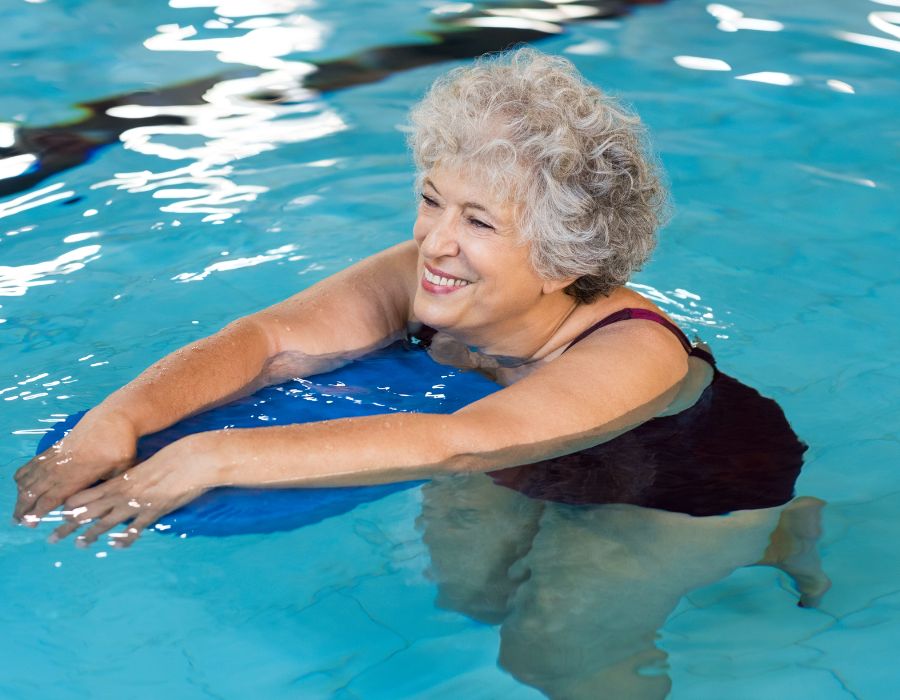Having a swimming pool at home offers a fantastic opportunity for low-impact, full-body workouts that cater to all age groups. Whether you’re looking to build strength, improve cardiovascular fitness, or simply stay active, exercising in the pool is an effective and refreshing option.
Julie said, “I feel a little self-conscious when I visit the local gym or public pool. Too many ‘body-beautiful’ people for my personal comfort. A home swimming pool is the perfect solution to exercise at my own pace and when it suits me.”
In this article, we’ll cover the best types of exercises to do in your pool, warm-up and cool-down routines, the ideal time of day to work out, and how exercise intensity should vary for children, adults, and elderly individuals.
Remember, you can exercise in any swimming pool, no matter how small. At Hydrocare Leisure, we offer a range of amazing swim-jet swim resistance products from our shop. They can help with your health and overall fitness.
Why Exercise in Water?
Water-based workouts provide several benefits, including:
- Low-impact movement, reducing strain on joints
- Increased resistance, making exercises more effective
- Improved flexibility and range of motion
- Enhanced cardiovascular fitness
- A cooling and refreshing environment, especially in warm climates
Best Pool Exercises for a Full-Body Workout
1. Warm-Up Routine (5-10 minutes)
Warming up is essential to prepare your body for exercise and prevent injuries. Since water naturally supports your weight, warming up in the pool helps loosen muscles with minimal strain. Try these simple movements:
- Water walking or jogging: Walk or jog in place in waist-deep water, gradually increasing speed.
- Arm circles: Extend your arms and make circular motions to loosen your shoulders.
- Leg swings: Hold onto the pool’s edge and gently swing each leg forward and backwards.
2. Full-Body Workout (20-30 minutes)
Here are some effective pool exercises:
- Aqua Jogging: Mimics running but with less impact on the joints. Great for cardio and endurance.
- Water Squats: Stand with feet shoulder-width apart and lower your body into a squat. Water resistance increases leg strength.
- Pool Push-Ups: Place your hands on the pool’s edge and push yourself up and down. This builds upper body strength.
- Flutter Kicks: Hold onto the pool wall and kick your legs for a great core and leg workout.
- Treading Water: Engage your core and legs by keeping yourself afloat for a set time.
3. Cool-Down Routine (5-10 minutes)
Cooling down helps bring your heart rate back to normal and prevents muscle stiffness. Try these moves:
- Gentle floating: Let your body relax on the water’s surface.
- Slow water walking: Walk slowly to bring your heart rate down.
- Stretching: Perform light stretches, such as pulling one knee to your chest or reaching for your toes underwater.
Best Time of Day to Exercise in the Pool
- Morning: Ideal for energising the body before starting the day. Water is usually at a comfortable temperature, and you avoid the midday heat.
- Evening: A great time to relax and unwind after a busy day. Helps reduce stress and improve sleep.
- Afternoon: If exercising in the afternoon, make sure to apply sunscreen and stay hydrated, as the sun is at its peak.
How Exercise Intensity Should Change by Age Group
For Children (Ages 5-12): Fun and Play-Based Workouts
- Keep exercises engaging with games like water tag or races.
- Focus on developing coordination and swimming skills.
- Avoid excessive endurance training; instead, encourage short bursts of activity.
For Adults (Ages 18-60): Strength and Cardio Balance
- Combine resistance exercises with cardio workouts like aqua jogging.
- Incorporate interval training (e.g., sprint swimming followed by slow swimming).
- Use pool weights or resistance bands for strength training.
For Seniors (Ages 60+): Low-Impact and Mobility-Focused Exercises
- Prioritise gentle movements like water aerobics, walking, and stretching.
- Focus on balance and core stability to reduce fall risks.
- Avoid high-intensity movements that may strain joints or cause fatigue.
James and Julie’s Summary of this Topic
Your home swimming pool is more than just a place to relax; it’s a fantastic workout space! By incorporating warm-up and cool-down exercises, choosing the best time to exercise, and adjusting intensity based on age, you can maximise the benefits of aquatic fitness.
So, dive in and make the most of your pool workouts!



